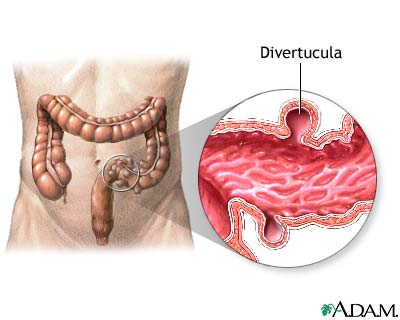
About half of all people over age 60 have small pouches called diverticula that bulge out through week areas in their colons. This condition is called diverticulosis. When these pouches become inflamed or infected, the condition is called diverticulitis. Either diverticulosis or diverticulitis is called diverticular disease.
If you have diverticulosis you normally don’t have any symptoms, but some people do have mild cramps, bloating, and constipation. Your doctor often discovers the disease in the course of doing diagnostic tests for other ailments. It seems as though the main cause of diverticulosis is a lowe-fiber diet. Fiber makes the stool softer and easier to pass and also prevents constipation. Constipation creates increased pressure in the colon, causing the weak spots to bulge out and become diverticula. A high-fiber diet is the best treatment for diverticulosis. Some fiber-rich foods to add to your diet are raw apples and pears, broccoli, carrots, spinach, summer squash, baked beans, lima beans, brown rice, bran flakes, and oatmeal.
The most common symptom of diverticulitis is abdominal pain, particularly around the left side of the lower abdomen or belly. If there is infection, the symptoms can increase to nausea, fever, vomiting, chills, cramping, and constipation. Diverticulitis can occur when stool or bacteria caught in the weak spots of the colon cause infection. It can also occur when certain foods get caught in the diverticula and cause inflammation.
You should avoid: nuts, popcorn, hulls, and sunflowers, caraway, pumpkin, and sesame seeds. If you have an attack of diverticulitis, your doctor will generally prescribe antibiotics, and may recommend a liquid diet to help rest your colon. The infection and inflammation should clear up in a few days.
Watching your diet can help control diverticular disease.
Article provided by the Visiting Nurse Services of New York
July 5, 2009 at 3:46 am
On the other hand, perhaps the author of this article needs to do a little more research before telling us to avoid things that might indeed be GOOD for us, to wit:
Among the study participants, 27% reported eating nuts twice a week or more, the highest intake group; 15% ate popcorn or corn at least twice a week. Researchers expected to see more cases of diverticulitis among people who ate the dubious foods more often. They found just the opposite: men with the highest intake of nuts had a 20% lower risk of diverticulitis than men with the lowest intake, consuming them less than once a month. There were 133 cases of diverticulitis among the 12,928 men who ate nuts at least two times a week, versus 199 cases among the 11,860 men who ate nuts less than once a month. The same trend held for popcorn intake: men in the highest intake group were 28% less likely to develop the disease than men with the lowest intake. The study’s findings about corn, however, were inconclusive, showing no statistically significant association.
How many people eat popcorn, or nuts – other than for an occasional snack? Incidently, as in so many instances, lack of exercise is a contributor.
August 19, 2009 at 6:21 am
Super informative column. Now I know how to get rid of toxins easily. I had a lot of trouble with my elimination habit which comes only one or two times a week. This is very bad. I have been educated on regular bowel movement. Reading colon health made it possible. I am very thankful of a site like this. Those who wants good information on colon health try reading this article. It is so informative!